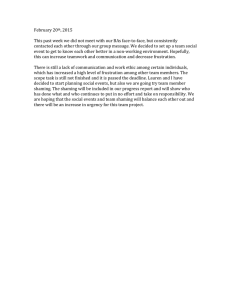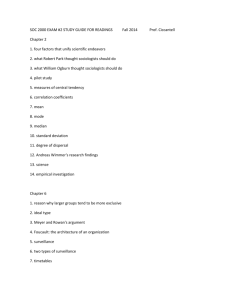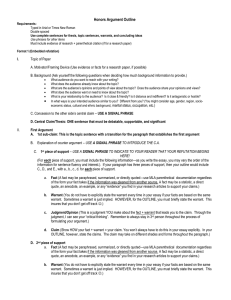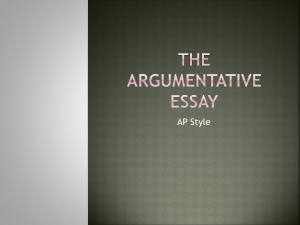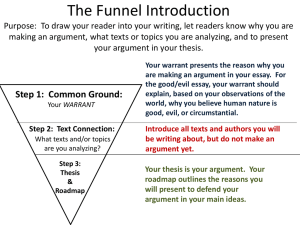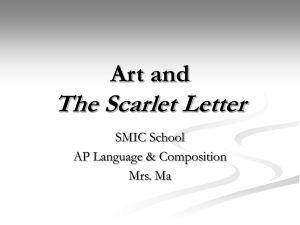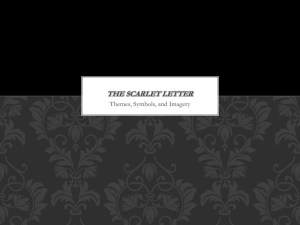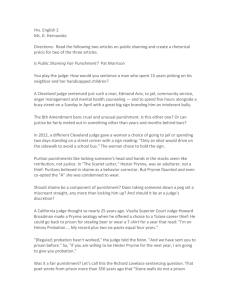Outline
advertisement
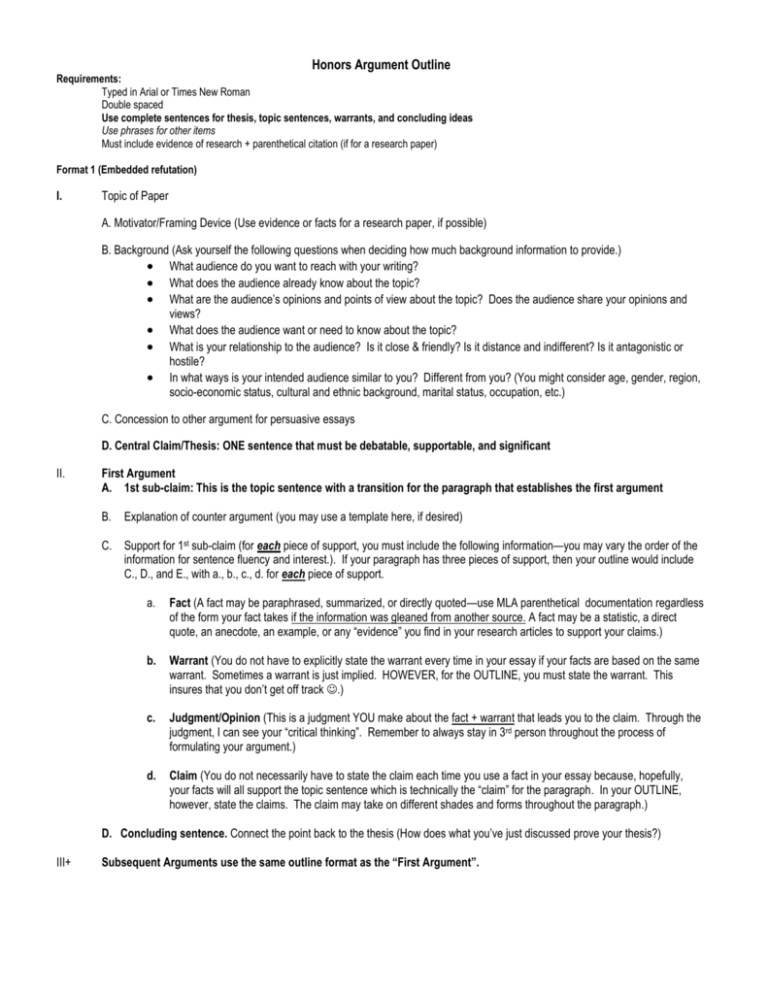
Honors Argument Outline Requirements: Typed in Arial or Times New Roman Double spaced Use complete sentences for thesis, topic sentences, warrants, and concluding ideas Use phrases for other items Must include evidence of research + parenthetical citation (if for a research paper) Format 1 (Embedded refutation) I. Topic of Paper A. Motivator/Framing Device (Use evidence or facts for a research paper, if possible) B. Background (Ask yourself the following questions when deciding how much background information to provide.) What audience do you want to reach with your writing? What does the audience already know about the topic? What are the audience’s opinions and points of view about the topic? Does the audience share your opinions and views? What does the audience want or need to know about the topic? What is your relationship to the audience? Is it close & friendly? Is it distance and indifferent? Is it antagonistic or hostile? In what ways is your intended audience similar to you? Different from you? (You might consider age, gender, region, socio-economic status, cultural and ethnic background, marital status, occupation, etc.) C. Concession to other argument for persuasive essays D. Central Claim/Thesis: ONE sentence that must be debatable, supportable, and significant II. First Argument A. 1st sub-claim: This is the topic sentence with a transition for the paragraph that establishes the first argument B. Explanation of counter argument (you may use a template here, if desired) C. Support for 1st sub-claim (for each piece of support, you must include the following information—you may vary the order of the information for sentence fluency and interest.). If your paragraph has three pieces of support, then your outline would include C., D., and E., with a., b., c., d. for each piece of support. a. Fact (A fact may be paraphrased, summarized, or directly quoted—use MLA parenthetical documentation regardless of the form your fact takes if the information was gleaned from another source. A fact may be a statistic, a direct quote, an anecdote, an example, or any “evidence” you find in your research articles to support your claims.) b. Warrant (You do not have to explicitly state the warrant every time in your essay if your facts are based on the same warrant. Sometimes a warrant is just implied. HOWEVER, for the OUTLINE, you must state the warrant. This insures that you don’t get off track .) c. Judgment/Opinion (This is a judgment YOU make about the fact + warrant that leads you to the claim. Through the judgment, I can see your “critical thinking”. Remember to always stay in 3rd person throughout the process of formulating your argument.) d. Claim (You do not necessarily have to state the claim each time you use a fact in your essay because, hopefully, your facts will all support the topic sentence which is technically the “claim” for the paragraph. In your OUTLINE, however, state the claims. The claim may take on different shades and forms throughout the paragraph.) D. Concluding sentence. Connect the point back to the thesis (How does what you’ve just discussed prove your thesis?) III+ Subsequent Arguments use the same outline format as the “First Argument”. V. Conclusion (or whatever paragraph happens to be your conclusion) A. Reworded thesis (complete sentence) B. Re-cap of points (Warning! Do not simply plop topic sentences in here! Make your points again in a new way.) C. Call to action: a suggestion and/or recommendation (complete sentences). Remember, WHO IS YOUR AUDIENCE? What do they know? What is their position? What action do you want them to take? YOU MUST KNOW WHAT YOU ‘WANT’ (Main Claim) BEFORE YOU STRUCTURE YOUR ARGUMENTS. Otherwise, you might lose focus and start rambling . D. Draw an insightful conclusion (This is where you make your connections to society, to the world. From the Pre’cis, this is the “this argument is significant because . . . “ ) E. Clincher- Tie back to the motivator. Complete the framing device. This sentence should be powerful. Sample First Argument Outline Thesis/Main Claim: Instituting shaming laws in a modern society is an inappropriate method of punishment for those who break the law. II. First Argument A. Inappropriately, shaming laws often indirectly or directly punish the innocent. B. Even though shaming laws may seem effective in some instances, the immoral implications of them demean society. C. Pearl example from The Scarlet Letter by Nathaniel Hawthorne a. Fact: “Behold, verily, there is the woman of the scarlet letter; and, of a truth, moreover, there is the likeness of the scarlet letter running along by her side! Come, therefore, and let us fling mud at them!” (Hawthorne 93). b. Warrant: Innocent people should not be punished. c. Judgment: Hester Prynne stood on the pillory for three hours and wears the scarlet letter daily, and it is unfair (opinion word) that Pearl is also punished by society for Hester’s sin. d. Claim: As illustrated, the effects of shaming laws cannot always be controlled, so they should not be utilized in a society trying to encourage its people to behave morally toward one another. D. Evidence from the article “Modern-day Puritans wring hands over Zumba Madam’s list of shame” published in the Christian Science Monitor in October 2012 a. Fact: “I can’t imagine, if the names are published, how I will ever even leave the house knowing what whispers would follow me every,” expresses a woman whose husband is supposedly on the list (“Modern” 1). b. Warrant: Innocent people should not be punished. c. Judgment: Publishing the list is vindictive (opinion word). d. Claim: Therefore, publishing the list may not be in the community’s best interest because it will turn people against each other. E. Example from “Iran must halt woman’s death by stoning” by Arslam Iftikhar published in CNN.com on July 8, 2010. a. Fact: “The majority of those sentenced to death by stoning [in Iran] are women, who suffer disproportionately from such punishment” according to Amnesty International (Iftikhar 2). b. Warrant: Laws should be equally and fairly applied. c. Judgment: Because more women are punished for adultery than men in Iran, the shaming law of stoning is discriminatory (opinion word). d. Claim: Therefore, shaming laws such as stoning should be discontinued because they are cruel and immoral. F. Finally, there are other appropriate and effective methods of punishment that deter crime and allow society to maintain its moral dignity. Sample First Argument Paragraph Inappropriately, shaming laws often indirectly or directly punish the innocent. Even though shaming laws may seem effective in some instances, the immoral implications of them demean society. For example, in the novel The Scarlet Letter by Nathaniel Hawthorne, the daughter of Hester Prynne, Pearl, is unfairly ostracized alongside her mother even though she has not committed the crime of adultery. As Pearl and her mother walk through the streets of Boston, the children declare “Behold, verily, there is the woman of the scarlet letter; and, of a truth, moreover, there is the likeness of the scarlet letter running along by her side! Come, therefore, and let us fling mud at them!” (Hawthorne 93). Innocent Pearl is punished by society as a result of her mother’s scarlet A which is unfair to Pearl. Because of human nature, the rippling effects of shaming laws cannot be controlled. Hester’s illegitimate child causes her enough pain without society having to make a mockery of her. Further, the article “Modern-day Puritans wring hands over Zumba Madam’s list of shame” published in the Christian Science Monitor in October 2012, discusses the effects of publishing a list of johns. It is evident that innocent wives and children will suffer if the list is actually published. One wife laments, “I can’t imagine, if the names are published, how I will ever even leave the house knowing what whispers would follow me every” (“Modern” 1). Other than to be vindictive, why would society support this action? Is making the list public necessary to punish the johns? In this case, it is evident how publically shaming the men may not be in the best interest of the community. Finally, often shaming laws have unintended results. An article titled, “Iran must halt woman’s death by stoning” by Arslam Iftikhar and published in CNN.com on July 8, 2010 confirms how laws can be manipulated. According to Amnesty International, “the majority of those sentenced to death by stoning [in Iran] are women, who suffer disproportionately from such punishment” (Iftikhar 2). Because more women than men are punished by the shaming law of stoning in Iran, discrimination has also become part of the law. Not only is this shaming law cruel, but it is also applied unfairly. If adultery is truly against the law in a society, then holding both parties equally accountable for the crime seems more equitable. There are many ways to punish law breakers without using shame, and these punishments can be just as effective in deterring crime. Therefore, shaming laws should not be utilized in a moral society.
